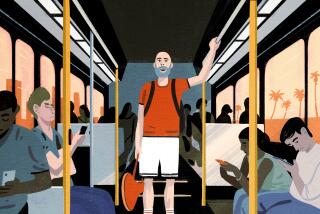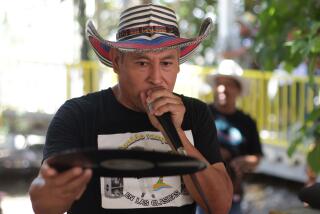La Paz’s cable-car system Teleferico a heady ride that bridges Bolivia’s values
- Share via
LA PAZ, Bolivia — Wedged into a crevice in the Andes, La Paz is high, steep, crowded and chaotic.
The administrative capital of Bolivia, with close to a million inhabitants, sits at nearly 12,000 feet in a bowl ringed by mountains. Terra-cotta-red buildings tumble down the hills, and the narrow, vertiginous streets are jammed with motorcycles, buses, cars, motor taxis and pedestrians. Triple-peaked Illimani, always covered with snow, towers dramatically over the city.
But above all of this is the brilliant Mi Teleférico, a 21st century transportation system uniquely suited to La Paz: Red, yellow and green gondolas glide up and down the hillsides, skimming the skyline. A ride costs about 50 cents for a one-way ticket.
To get to the red line from our hotel, we hiked about a half-mile up a hill, then walked through gridlocked traffic circles while dodging vendors, cars, buse
The Estación Central/Taypi Uta station is futuristic, spotless and high-tech. Each gondola has solar panels on top that power the doors, lights and Wi-Fi for passengers’ use.
“The basic view for us as a country is that we must both modernize and respect the Earth,” said Marco Valverde Carrasco, the Bolivian consul general in Los Angeles. “We are integrating a lot of green technology in all of our modernization. We believe we should develop, but not at a pace that affects ecosystems.”
When we entered the eight-person cabin, the city dropped away and became silent. The snowy peaks of the Cordillera Real rose to the east of La Paz as we floated toward El Alto, the second-largest city in Bolivia adjacent to La Paz on the Altiplano highland.
The Teleférico offers spectacular views from each line, as well as bird’s-eye views of life in La Paz. You can see distant mountains and clouds, but also soccer fields, cemeteries and guinea pigs being raised in people’s backyards. Locals estimate a Teleférico ride from El Alto to the center of La Paz is about three times faster than taking a bus or taxi. Along with pedestrian bridges and more public transportation, Valverde hopes the Teleférico will ease the traffic gridlock that plagues the city. But they are as much inspiration as solution — we could have ridden them all day.
MORE:
Mining the history of a Bolivian silver town well worth the trip
Bolivia’s raw beauty calls to travelers looking for adventure
Bolivia’s ethereal Salar de Uyuni salt flats will shake your worldview
More to Read
Sign up for The Wild
We’ll help you find the best places to hike, bike and run, as well as the perfect silent spots for meditation and yoga.
You may occasionally receive promotional content from the Los Angeles Times.






